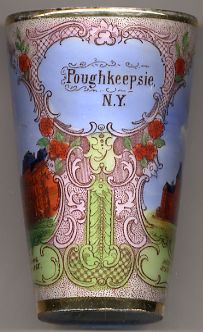
|
Poughkeepsie is located in the Hudson River Valley midway between New York City and Albany
and serves as the county seat of Dutchess County. The name derives from a Native American word (roughly U-puku-ipi-sing), meaning
"the reed-covered lodge by the little-water place," referring to a spring or stream feeding into the Hudson River, south of the present downtown area.
Poughkeepsie is known as "The Queen City of the Hudson."
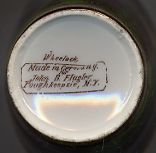
The site of Poughkeepsie was first settled by a New Netherland Dutchman, Barent Baltus, before 1659. It was founded in 1687 by his son, Baltus Barent van Kleeck,
who built the first house of record there in 1702. The community was set off from the Town of Poughkeepsie when it became an incorporated village in 1799.
The City of Poughkeepsie was chartered in 1854. Outside of municipal designations, the City and Town of Poughkeepsie are generally viewed as a single place,
and are commonly referred to as Poughkeepsie, with a current combined population of approximately 75,000.
Spared from battle during the American Revolution, Poughkeepsie became the second capital of New York. In 1788 the Ratification Convention for New York State,
which included Alexander Hamilton, John Jay, and George Clinton, assembled at the courthouse on Market Street, debated and ratified the United States Constitution.
With its ratification, New York entered the new union as the eleventh of the original thirteen colonies to join together as the United States of America.
Early on, Poughkeepsie was also a major center for whale rendering, and during the 19th century industry flourished through shipping, hatteries, papermills, and
several breweries along the Hudson River, including some owned by Matthew Vassar, founder of Vassar College. Due to the area's natural beauty and proximity to
New York City, families such as the Astors, Rogers and Vanderbilts built palatial weekend homes nearby. The city is also home to the oldest continuously operating
entertainment venue in the state, the Bardavon 1869 Opera House.
[Text adapted from http://en.wikipedia.org/wiki/Poughkeepsie,_New_York]
|
 Hudson River State Hospital [right]
is a former New York state psychiatric hospital located in the Town of Poughkeepsie.
The entire facility was built over the last three decades of the 19th century, at great cost. Once complete, it would be used as intended for much of
the first half of the next century. As psychiatry moved away from inpatient treatments, it began to decline in use until its closure at century's end.
New York had opened what has since become Utica Psychiatric Center in 1843, the first state-run institution for the mentally ill. By the Civil War
it was reaching its capacity, so in 1866 a state commission was given the task to look for a site for a second hospital in the Hudson Valley between
New York and Albany, to serve New York City and the counties of Eastern New York.
Construction began in 1868 and the main building was completed and opened, with 40 patients admitted, in October 1871. As work continued on other
structures planned for the complex, so did the cost overruns. In 1873, the year county residents had been promised the hospital would be finished,
the New York Times ran an editorial harshly criticizing the board for not only having gone way over budget but for lavish extravagance and waste.
Construction continued until 1895, when further money could not be found. Despite this expenditure of time and money, the hospital's original plan
was still not complete, and never would be. Buildings continued to be opened and reopened in the 20th century, and as late as 1952 the institution was
treating as many as 6,000 patients. Changes in the treatment of mental illness, such as psychotherapy and psychotropic drugs, were making large-scale
facilities relics and allowing more patients to lead more normal lives without being committed. By the late 1970s the hospital administration had decided
to shut down the two main wings as few patients were residing in them and due to neglect some of the floors had collapsed. In the 1990s, more and more
of the hospital site would be abandoned as its services were needed less and less. It was consolidated with another Dutchess County mental hospital,
Hudson Valley Psychiatric Center, in 1994 and closed in 2001. The center moved operations into a much smaller building nearby. The state had decided
to sell the property for redevelopment, and in 2005 the Empire State Development Corporation sold 156 acres (63 ha) including the Main Building to
Hudson Heritage LLC, a subsidiary of the Chazen Companies, for $2.75 million. Hudson Heritage and Chazen plan to thoroughly renovate the Main Building
into a combination hotel/apartment complex as the centerpiece of a residential/commercial campus, Hudson Heritage Park. Hudson River State Hospital [right]
is a former New York state psychiatric hospital located in the Town of Poughkeepsie.
The entire facility was built over the last three decades of the 19th century, at great cost. Once complete, it would be used as intended for much of
the first half of the next century. As psychiatry moved away from inpatient treatments, it began to decline in use until its closure at century's end.
New York had opened what has since become Utica Psychiatric Center in 1843, the first state-run institution for the mentally ill. By the Civil War
it was reaching its capacity, so in 1866 a state commission was given the task to look for a site for a second hospital in the Hudson Valley between
New York and Albany, to serve New York City and the counties of Eastern New York.
Construction began in 1868 and the main building was completed and opened, with 40 patients admitted, in October 1871. As work continued on other
structures planned for the complex, so did the cost overruns. In 1873, the year county residents had been promised the hospital would be finished,
the New York Times ran an editorial harshly criticizing the board for not only having gone way over budget but for lavish extravagance and waste.
Construction continued until 1895, when further money could not be found. Despite this expenditure of time and money, the hospital's original plan
was still not complete, and never would be. Buildings continued to be opened and reopened in the 20th century, and as late as 1952 the institution was
treating as many as 6,000 patients. Changes in the treatment of mental illness, such as psychotherapy and psychotropic drugs, were making large-scale
facilities relics and allowing more patients to lead more normal lives without being committed. By the late 1970s the hospital administration had decided
to shut down the two main wings as few patients were residing in them and due to neglect some of the floors had collapsed. In the 1990s, more and more
of the hospital site would be abandoned as its services were needed less and less. It was consolidated with another Dutchess County mental hospital,
Hudson Valley Psychiatric Center, in 1994 and closed in 2001. The center moved operations into a much smaller building nearby. The state had decided
to sell the property for redevelopment, and in 2005 the Empire State Development Corporation sold 156 acres (63 ha) including the Main Building to
Hudson Heritage LLC, a subsidiary of the Chazen Companies, for $2.75 million. Hudson Heritage and Chazen plan to thoroughly renovate the Main Building
into a combination hotel/apartment complex as the centerpiece of a residential/commercial campus, Hudson Heritage Park.
The  main building
has been designated a National Historic Landmark due to its exemplary High Victorian Gothic architecture, the first use of that style for an American
institutional building. Frederick Clarke Withers designed the hospital's buildings in 1867. Calvert Vaux and Frederick Law Olmsted designed the grounds.
It was intended to be completed quickly, but went far over its original schedule and budget and remained under construction for almost a quarter century
after it first opened. A century later it was slowly closed down as psychiatric treatment had changed enough that large hospitals were no longer needed,
and the facility moved into smaller quarters nearby. The building was closed down in 2003 and since then has fallen into a state of disrepair. It was
seriously damaged in a 2007 fire. main building
has been designated a National Historic Landmark due to its exemplary High Victorian Gothic architecture, the first use of that style for an American
institutional building. Frederick Clarke Withers designed the hospital's buildings in 1867. Calvert Vaux and Frederick Law Olmsted designed the grounds.
It was intended to be completed quickly, but went far over its original schedule and budget and remained under construction for almost a quarter century
after it first opened. A century later it was slowly closed down as psychiatric treatment had changed enough that large hospitals were no longer needed,
and the facility moved into smaller quarters nearby. The building was closed down in 2003 and since then has fallen into a state of disrepair. It was
seriously damaged in a 2007 fire.
[Text adapted from http://en.wikipedia.org/wiki/Hudson_River_State_Hospital]
| 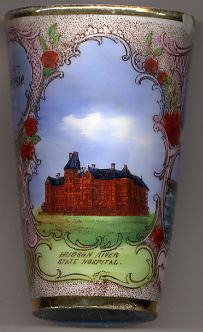
|
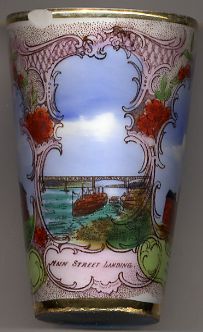
|
The  Main Street Landing [left]
became the main public dock for the city in 1811, when steamboats began to stop at this central docking site. By 1867, with diminished river traffic,
the consolidation of the four river landings along Poughkeepsie's waterfront began. By 1873, steamboats ran only to one, the Main Street landing. Main Street Landing [left]
became the main public dock for the city in 1811, when steamboats began to stop at this central docking site. By 1867, with diminished river traffic,
the consolidation of the four river landings along Poughkeepsie's waterfront began. By 1873, steamboats ran only to one, the Main Street landing.
[Text adapted from Harvey K. Flad, Clyde Griffen: Main Street to mainframes: landscape and social change in Poughkeepsie, SUNY Press, 2009, pp.27, 37:
http://books.google.com/books?id=BCXXlztlWUUC&pg=PA27&lpg=PA27&dq=Poughkeepsie,+main+street+landing&source=bl&ots=8NvDu7IpO3&sig=JnntQiFuRcUOwdhwOEWfrokz3XE&hl=en&ei=W_f9TNfhEIvwsgbl3rGWBg&sa=X&oi=book_result&ct=result&resnum=1&ved=0CBQQ6AEwAA#v=onepage&q=Poughkeepsie%2C%20main%20street%20landing&f=false]
|
 Vassar College [right]
was one of the first of the Seven Sisters (seven liberal arts colleges in the Northeastern United States that are/were historically women's colleges:
Barnard College (New York City), Bryn Mawr College (Bryn Mawr, PA), Mount Holyoke College (South Hadley, MA),
Radcliffe College (Cambridge, MA), Smith College (Northampton, MA), Vassar College and Wellesley College (Wellesley, MA). Vassar College was
founded by its namesake, brewer Matthew Vassar, in 1861. The first person appointed to the Vassar faculty was the astronomer Maria Mitchell, in 1865.
Vassar adopted coeducation in 1969 after Vassar's trustees declined an offer to merge with Yale University in New Haven, CT.
However, immediately following World War II, Vassar accepted a very small number of male students on the G.I. Bill. Because Vassar's charter prohibited
male matriculants, the graduates were given diplomas via the University of the State of New York. These were reissued under the Vassar title after the school
formally became co-ed. Vassar College [right]
was one of the first of the Seven Sisters (seven liberal arts colleges in the Northeastern United States that are/were historically women's colleges:
Barnard College (New York City), Bryn Mawr College (Bryn Mawr, PA), Mount Holyoke College (South Hadley, MA),
Radcliffe College (Cambridge, MA), Smith College (Northampton, MA), Vassar College and Wellesley College (Wellesley, MA). Vassar College was
founded by its namesake, brewer Matthew Vassar, in 1861. The first person appointed to the Vassar faculty was the astronomer Maria Mitchell, in 1865.
Vassar adopted coeducation in 1969 after Vassar's trustees declined an offer to merge with Yale University in New Haven, CT.
However, immediately following World War II, Vassar accepted a very small number of male students on the G.I. Bill. Because Vassar's charter prohibited
male matriculants, the graduates were given diplomas via the University of the State of New York. These were reissued under the Vassar title after the school
formally became co-ed.
The  main building
built in 1861 by renowned architect James Renwick, Jr, had the most interior space of any building in the United States, until the US Capitol
at Washington, DC was completed in 1868. main building
built in 1861 by renowned architect James Renwick, Jr, had the most interior space of any building in the United States, until the US Capitol
at Washington, DC was completed in 1868.
[Text adapted from http://en.wikipedia.org/wiki/Vassar_College;
http://en.wikipedia.org/wiki/Seven_Sisters_(colleges)]
| 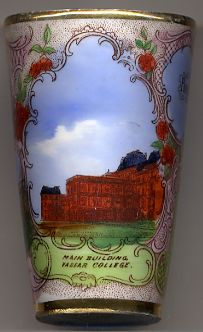
| | |







![[scale]](lineal.jpg)